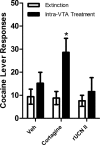Augmented cocaine seeking in response to stress or CRF delivered into the ventral tegmental area following long-access self-administration is mediated by CRF receptor type 1 but not CRF receptor type 2
- PMID: 21813699
- PMCID: PMC3449095
- DOI: 10.1523/JNEUROSCI.1393-11.2011
Augmented cocaine seeking in response to stress or CRF delivered into the ventral tegmental area following long-access self-administration is mediated by CRF receptor type 1 but not CRF receptor type 2
Abstract
Stressful events are determinants of relapse in recovering cocaine addicts. Excessive cocaine use may increase susceptibility to stressor-induced relapse through alterations in brain corticotropin-releasing factor (CRF) regulation of neurocircuitry involved in drug seeking. We previously reported that the reinstatement of cocaine seeking by a stressor (footshock) is CRF dependent and is augmented in rats that self-administered cocaine under long-access (LgA; 6 h daily) conditions for 14 d when compared with rats provided shorter daily cocaine access [short access (ShA) rats; 2 h daily]. Further, we have demonstrated that reinstatement in response to intracerebroventricular CRF administration is heightened in LgA rats. This study examined the role of altered ventral tegmental area (VTA) responsiveness to CRF in intake-dependent increases in CRF- and stress-induced cocaine seeking. Bilateral intra-VTA administration of CRF (250 or 500 ng/side) produced reinstatement in LgA but not ShA rats. In LgA rats, intra-VTA CRF-induced reinstatement was blocked by administration of the CRF-receptor type 1 (CRF-R1) antagonist antalarmin (500 ng/side) or CP-376395 (500 ng/side), but not the CRF-R2 antagonist astressin-2B (500 ng or 1 μg/side) or antisauvagine-30 (ASV-30; 500 ng/side) into the VTA. Likewise, intra-VTA antalarmin, but not astressin-2B, blocked footshock-induced reinstatement in LgA rats. By contrast, neither intra-VTA antalarmin nor CP-376395 altered food-reinforced lever pressing. Intra-VTA injection of the CRF-R1-selective agonist cortagine (100 ng/side) but not the CRF-R2-selective agonist rat urocortin II (rUCN II; 250 ng/side) produced reinstatement. These findings reveal that excessive cocaine use increases susceptibility to stressor-induced relapse in part by augmenting CRF-R1-dependent regulation of addiction-related neurocircuitry in the VTA.
Figures





Similar articles
-
Enhanced CRFR1-Dependent Regulation of a Ventral Tegmental Area to Prelimbic Cortex Projection Establishes Susceptibility to Stress-Induced Cocaine Seeking.J Neurosci. 2018 Dec 12;38(50):10657-10671. doi: 10.1523/JNEUROSCI.2080-18.2018. Epub 2018 Oct 24. J Neurosci. 2018. PMID: 30355627 Free PMC article.
-
Antagonism of GABA-B but not GABA-A receptors in the VTA prevents stress- and intra-VTA CRF-induced reinstatement of extinguished cocaine seeking in rats.Neuropharmacology. 2016 Mar;102:197-206. doi: 10.1016/j.neuropharm.2015.11.013. Epub 2015 Nov 17. Neuropharmacology. 2016. PMID: 26596556 Free PMC article.
-
Stress-induced relapse to cocaine seeking: roles for the CRF(2) receptor and CRF-binding protein in the ventral tegmental area of the rat.Psychopharmacology (Berl). 2007 Aug;193(2):283-94. doi: 10.1007/s00213-007-0782-3. Epub 2007 Apr 17. Psychopharmacology (Berl). 2007. PMID: 17437087
-
A ventral tegmental CRF-glutamate-dopamine interaction in addiction.Brain Res. 2010 Feb 16;1314:38-43. doi: 10.1016/j.brainres.2009.09.101. Epub 2009 Oct 1. Brain Res. 2010. PMID: 19800323 Free PMC article. Review.
-
The role of CRF and CRF-related peptides in the dark side of addiction.Brain Res. 2010 Feb 16;1314:3-14. doi: 10.1016/j.brainres.2009.11.008. Epub 2009 Nov 11. Brain Res. 2010. PMID: 19912996 Free PMC article. Review.
Cited by
-
The Dorsal Agranular Insular Cortex Regulates the Cued Reinstatement of Cocaine-Seeking, but not Food-Seeking, Behavior in Rats.Neuropsychopharmacology. 2015 Sep;40(10):2425-33. doi: 10.1038/npp.2015.92. Epub 2015 Apr 3. Neuropsychopharmacology. 2015. PMID: 25837282 Free PMC article.
-
Neurochemical mechanisms and neurocircuitry underlying the contribution of stress to cocaine seeking.J Neurochem. 2021 Jun;157(5):1697-1713. doi: 10.1111/jnc.15340. Epub 2021 Mar 22. J Neurochem. 2021. PMID: 33660857 Free PMC article. Review.
-
Connecting the pathology of posttraumatic stress and substance use disorders: monoamines and neuropeptides.Pharmacol Biochem Behav. 2014 Feb;117:61-9. doi: 10.1016/j.pbb.2013.12.001. Epub 2013 Dec 11. Pharmacol Biochem Behav. 2014. PMID: 24333548 Free PMC article. Review.
-
CB1 receptor antagonism blocks stress-potentiated reinstatement of cocaine seeking in rats.Psychopharmacology (Berl). 2016 Jan;233(1):99-109. doi: 10.1007/s00213-015-4092-x. Epub 2015 Oct 12. Psychopharmacology (Berl). 2016. PMID: 26455361 Free PMC article.
-
Episodic Social Stress-Escalated Cocaine Self-Administration: Role of Phasic and Tonic Corticotropin Releasing Factor in the Anterior and Posterior Ventral Tegmental Area.J Neurosci. 2016 Apr 6;36(14):4093-105. doi: 10.1523/JNEUROSCI.2232-15.2016. J Neurosci. 2016. PMID: 27053215 Free PMC article.
References
-
- Ahmed SH, Koob GF. Cocaine- but not food-seeking behavior is reinstated by stress after extinction. Psychopharmacology. 1997;132:289–295. - PubMed
-
- Ahmed SH, Koob GF. Transition from moderate to excessive drug intake: change in hedonic set point. Science. 1998;282:298–300. - PubMed
-
- Chen YL, Obach RS, Braselton J, Corman ML, Forman J, Freeman J, Gallaschun RJ, Mansbach R, Schmidt AW, Sprouse JS, Tingley FD, Iii, Winston E, Schulz DW. 2-aryloxy-4-alkylaminopyridines: discovery of novel corticotropin-releasing factor 1 antagonists. J Med Chem. 2008;51:1385–1392. - PubMed
Publication types
MeSH terms
Substances
Grants and funding
LinkOut - more resources
Full Text Sources
Other Literature Sources
Medical
Molecular Biology Databases
Miscellaneous
